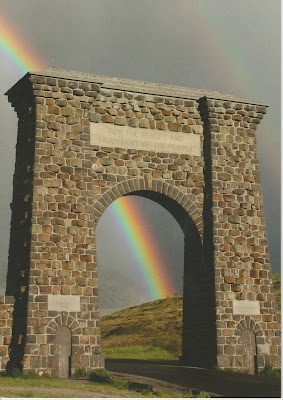Near Pitfure Church, Rogart, East Sutherland, Scotland, ca 1950s
Today’s used postcard, published by Anne Baxter, Golspie & Train, features an image by Photo Precision Ltd., St. Ives, Cambs. The number R7711 is printed at the bottom center on the reverse. This is another card that was found in a shoebox of mixed cards in an antique mall.
The country scene is appealing and includes a little patch of heather, lower right corner. Heather is one of the traditional flowers of Scotland but it also grows in the mountains in the Pacific Northwest. The road winding through the valley of Strathfleet leads to Lairg a village in the Highlands. While most of the settlements in the Highlands are along the coast, Lairg is inland. It used to be known as the Crossroads of the North from the four roads that meet in the village.
Rogart is a small village in the Highlands that was the home of Major Andrew MacDonald. MacDonald is known to have fought in the French and Indian War. The Rogart railway station opened in 1886 and allowed the village to expand around the older village.
Open-air preaching was traditional before 1900 when there was a division in the United Free Church. In 1929 most of the United Free Church joined the Church of Scotland but there were still some bad feelings and the congregations remained separate until around 1948 when they were officially united into one congregation.
One story regarding the church building was that in the old days prior to the split, the site for the building was refused by McLeod, the land owner. McLeod claimed as “Lord of the soil and therefore entitled to prevent God’s creatures from enjoying that soil for any purpose which he does not approve. He will let it out for culture, and give houses in which to eat and drink and sleep, but not a spot on which to build a house of God, to worship.” Prior the building of the church, the community asked if they could meet on the beach above the high-water mark. The answer was that they could put up a tent and meet there for worship. Between 1900 and the completion of the building members met in local homes and sometimes in the open-air. In 1906 fundraising was started to build a new church at Pitfure. The project was completed in 1910. Robert J. MacBeth of Inverness was the architect. At the jubilee celebration in 1960 an open-air meeting was held behind the church just as the sun was setting over the hills.
The stamp shows a profile view of Queen Elizabeth with the Lion of Scotland at the upper left. This design with various values was printed for use in Scotland in the 1950s.
For additional information, see:
https://en.wikipedia.org/wiki/Rogart
https://en.wikipedia.org/wiki/Lairg
https://en.wikipedia.org/wiki/Battle_of_Skibo_and_Strafleet
https://rogartheritage.co.uk/places/pitfure-church












